Fun with Purpose: Turning Campus Activities into Strategic Engagement Tools
If you think student engagement is just about pizza parties, icebreakers, or the new hot comedian, think again. Data from NACA’s Making the Case for Campus Activities report confirms what many campus professionals already know: intentional engagement drives student success. Students who feel connected to their campus are more likely to stay enrolled, thrive socially, and graduate on time.
For two decades, the fun dept. has been helping translate these findings into action by designing programs that go beyond simple entertainment. Instead of focusing on “what’s fun for a night,” we focus on experiences that create connection, belonging, and measurable outcomes. Here’s how you can adopt this intentional approach on your campus.
1. Design for Belonging
A strong sense of belonging is one of the biggest predictors of student success. Yet students today are facing increased social isolation, with many reporting that they struggle to feel like they are part of their college community. Find your shared experience!
Creating belonging begins with programming that intentionally reflects students’ diverse experiences, cultures, and identities. This means taking time to learn about who your students are and what matters to them. For some campuses, it may mean holding cultural festivals or affinity-based social mixers. For others, it might mean partnering with student organizations to co-create events that represent underrepresented voices.
Inclusive programming doesn’t happen by accident—it’s built through deliberate listening and collaboration. Consider forming an engagement advisory group made up of students from different backgrounds, majors, and life experiences. Give them space to share what events feel welcoming and what barriers keep students from participating. Small shifts, such as creating quiet spaces at large events for neurodiverse students or offering late-night programming for commuter students, can make a big difference in who feels included.
2. Offer a Spectrum of Involvement
Not every student is ready, or wants, to lead a club or plan a major event. Some just need a quick way to meet people or feel included without committing to a weekly schedule. Offering a variety of engagement options is crucial.
Play at your speed - fun isn’t forced. Low-commitment events like pop-up games, grab-and-go creative activities, or five-minute contests are great entry points for students who are testing the waters socially. These “low-barrier” opportunities can lead to deeper involvement later, once students feel more comfortable. Determining your own Play Personality makes for an all-inclusive and non-threatening experience.
On the other end of the spectrum, offer leadership and skill-building opportunities for students who want more responsibility. Roles like event emcees, peer mentors, or activity facilitators provide valuable experience and encourage students to take ownership of their campus culture. By offering different levels of involvement, you meet students where they are instead of expecting them to conform to one model of engagement.
3. Social Connection
The true goal of campus events isn’t just entertainment; it’s connection and experience. When events are designed intentionally, they create organic opportunities for students to interact, collaborate, and bond.
Think about the difference between watching a movie in a lecture hall versus hosting a themed trivia night. The first might get students in the room, but the second gets them talking, laughing, and meeting new people. Simple design tweaks—like including small group challenges, conversation prompts, or opportunities for shared storytelling—can transform a standard event into a community-building experience.
Even traditional welcome week activities can be re-imagined with this mindset. Instead of having every student passively listen to the same presentations, consider designing interactive stations where students can meet peers with shared interests, participate in quick team challenges, or leave with a personal connection and a reason to come back.
4. Empower Student Leaders
Student leaders, whether RAs, orientation leaders, or club officers, peer mentors are the secret sauce of strong campus engagement. When trained well, these students can create connections in ways that professional staff often can’t. Armed with the proper tools of the Shared Experience and Play Personality, leaders set themselves up for success.
The key is to give them the tools and autonomy to actively foster community, not just enforce rules or manage logistics. Provide short, interactive training sessions focused on facilitation, inclusion, and fun-building techniques. Provide them with a straightforward framework for transforming an ordinary meeting or event into a memorable one.
Leadership development through engagement programming has a powerful ripple effect. Students who learn how to build community and create positive experiences often carry these skills into their future careers and lives. That means every effort you put into empowering leaders not only impacts current engagement but also prepares students to be community builders long after graduation.
5. Measure What Matters
For campus leaders, engagement is only as good as the results it produces. That’s why measuring outcomes is crucial. While headcounts are easy to track, they only tell part of the story.
Post-event surveys are an excellent way to capture qualitative insights. Ask students how the event made them feel: Did they meet someone new? Did they feel more connected to the campus afterward? Did the experience encourage them to attend other events?
Pairing these qualitative responses with participation data (e.g., demographics, frequency of attendance, first-time attendees) gives a fuller picture of success. Over time, this data can demonstrate how engagement contributes to retention, inclusion, and overall student satisfaction. Being able to show this measurable “return on fun” helps secure support from administrators and ensures ongoing investment in student programming.
There are excellent real-time tools available to measure the success of an event and/or longer-term programming.
Three Quick Wins for Any Campus
- Add Micro-Engagements: Short, spontaneous activities (like five-minute stress busters during finals week or surprise social challenges in high-traffic areas) can dramatically boost connection without requiring a whole event budget.
- Leverage Peer Ambassadors: Identify students who are natural connectors and give them simple roles, like greeting event attendees, starting conversations, or leading quick team challenges.
- Use Data for Storytelling: Share success stories and feedback from past events with both students and campus leadership. When people see real impact, participation and support often grows organically.
Why This Matters Now More Than Ever
Today’s students face unique challenges: higher rates of anxiety, increased social isolation, and competing demands on their time. Intentional campus programming isn’t just nice to have—it’s a critical component of student wellness and academic success. Creating space for students to connect, relax, and have fun can dramatically improve their overall college experience.
The good news? You don’t need massive budgets or elaborate productions to achieve this. What you need is clarity of purpose and a commitment to using engagement as a strategic tool rather than a side activity.
When done right, campus activities can strengthen belonging, improve retention, and foster lifelong skills. And yes, they can be a lot of fun, too.






